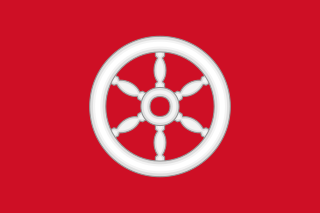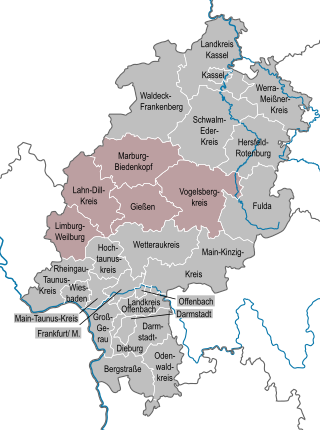
Hesse or Hessia, officially the State of Hesse, is a state in Germany. Its capital city is Wiesbaden, and the largest urban area is Frankfurt, which is also the country's principal financial centre. Two other major historic cities are Darmstadt and Kassel. With an area of 21,114.73 square kilometers and a population of over six million, it ranks seventh and fifth, respectively, among the sixteen German states. Frankfurt Rhine-Main, Germany's second-largest metropolitan area, is mainly located in Hesse.

Kassel is a city on the Fulda River in northern Hesse, in central Germany. It is the administrative seat of the Regierungsbezirk Kassel and the district of the same name, and had 201,048 inhabitants in December 2020. The former capital of the state of Hesse-Kassel, it has many palaces and parks, including the Bergpark Wilhelmshöhe, which is a UNESCO World Heritage Site. Kassel is also known for the documenta exhibitions of contemporary art. Kassel has a public university with 25,000 students (2018) and a multicultural population.

The Electorate of Mainz, previously known in English as Mentz and by its French name Mayence, was one of the most prestigious and influential states of the Holy Roman Empire. In the hierarchy of the Catholic Church, the Archbishop-Elector of Mainz was also the Primate of Germany, a purely honorary dignity that was unsuccessfully claimed from time to time by other archbishops. There were only two other ecclesiastical Prince-electors in the Empire: the Electorate of Cologne and the Electorate of Trier.

The Fulda is a river of Hesse and Lower Saxony, Germany. It is one of two headstreams of the Weser. The Fulda is 220.4 kilometres (137.0 mi) long.

Siddhartha: An Indian novel is a 1922 novel by Hermann Hesse that deals with the spiritual journey of self-discovery of a man named Siddhartha during the time of the Gautama Buddha. The book, Hesse's ninth novel, was written in German, in a simple, lyrical style. It was published in the United States in 1951 by New Directions Publishing and became influential during the 1960s. Hesse dedicated the first part of it to the French writer Romain Rolland and the second part to Wilhelm Gundert, his cousin.

The Lahn is a 245.6-kilometre-long (152.6 mi), right tributary of the Rhine in Germany. Its course passes through the federal states of North Rhine-Westphalia (23.0 km), Hesse (165.6 km), and Rhineland-Palatinate (57.0 km).

Hesse-Homburg was a state of the Holy Roman Empire and a sovereign member of the German Confederation. It was formed into a separate landgraviate in 1622 by the landgrave of Hesse-Darmstadt; it was to be ruled by his son, although it did not become independent of Hesse-Darmstadt until 1668. It was briefly divided into Hesse-Homburg and Hesse-Homburg-Bingenheim; but these parts were reunited in 1681.

Rhenish Hesse or Rhine Hesse is a region and a former government district in the German state of Rhineland-Palatinate. It is made up of territories west of the Upper Rhine river that were part of the Grand Duchy of Hesse and its successor in the Weimar Republic, the People's State of Hesse from 1816 to 1945. The hilly countryside is largely devoted to vineyards, comprising the Rheinhessen wine region.

Selters (Taunus) is a municipality with 8,000 inhabitants north of Bad Camberg in Limburg-Weilburg district in Hesse, Germany.

Dombach is a river of Hesse, Germany. It flows into the Emsbach near Bad Camberg.

Eisenbach is a river of Hesse, Germany. Its source is near the village of Haintchen. It flows into the Emsbach near Niederselters.

Laubusbach is a river of Hesse, Germany. It flows into the Emsbach in Oberbrechen.

Wörsbach is a river of Hesse, Germany. It passes through Idstein, and flows into the Emsbach near Niederbrechen.
Hainbach may refer to the following:

The region of Middle Hesse is one of three planning regions in the German state of Hesse, alongside North and South Hesse. Its territory is identical with that of the administrative province of Gießen and covers the counties of Limburg-Weilburg, Lahn-Dill-Kreis, Gießen, Marburg-Biedenkopf and Vogelsbergkreis. The Middle Hesse Regional Assembly, which decides on the regional plan, currently consists of 31 members chosen by the five counties and the three towns with special status: Gießen, Marburg and Wetzlar. The regional assembly has tasked the governing president (Regierungspräsident) with delivering regional management. The Mid-Hesse Regional Management Association was founded on 22 January 2003.
As well as being a low mountain range, the Westerwald is also a natural region in the system of natural regional division of Germany. Within that it is a major unit group with the number "32". According to this system the major unit group of the Westerwald belongs to the basement plate (Grundgebirgsschollenland), which describes the type of mountain-building process by which it was formed. The major unit group extends across the states of Hesse, North Rhine-Westphalia and Rhineland-Palatinate. It is roughly bounded by the valleys of the Lahn, Rhine and Sieg, whereby the hills immediately south of the Heller and Sieg are not considered to be part of it.

Kloster Gnadenthal is the name of a former Cistercian nunnery dating back to 1235 which was changed to a Protestant Stift for women in 1564, and became the centre of the ecumenical community Jesus-Bruderschaft in 1969. It is part of Hünfelden, Hesse, Germany.















